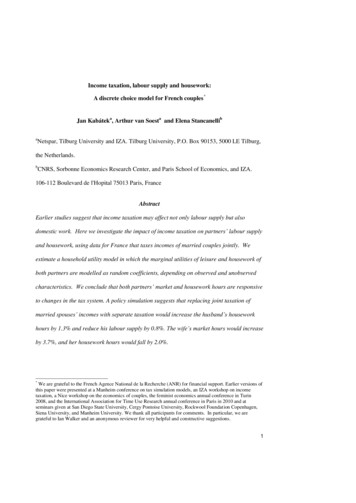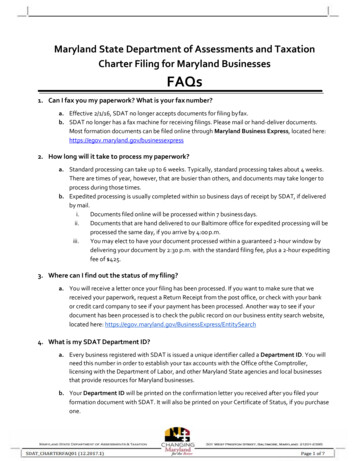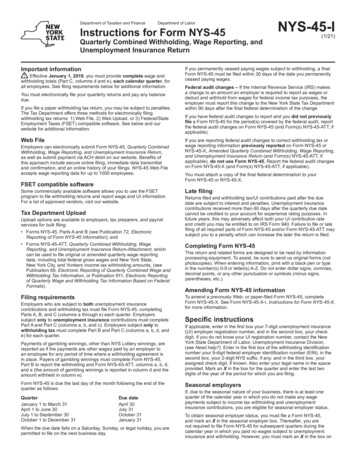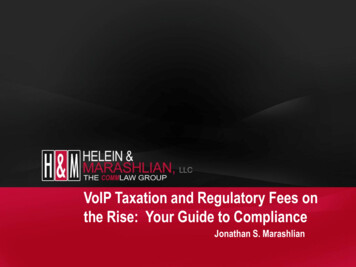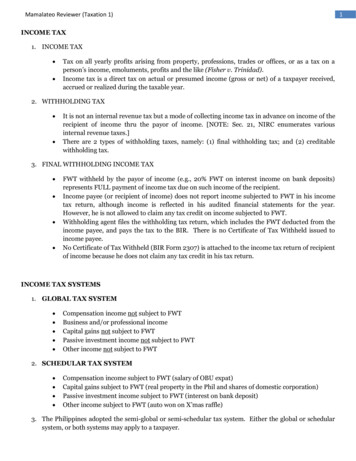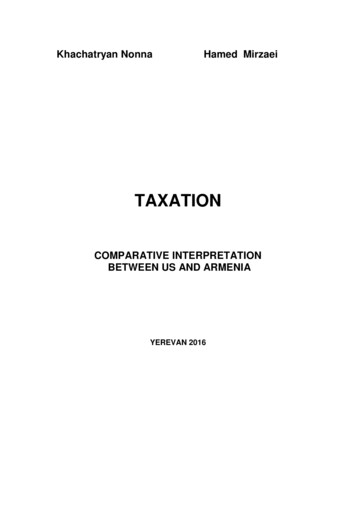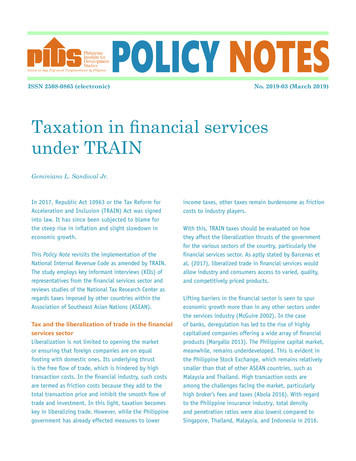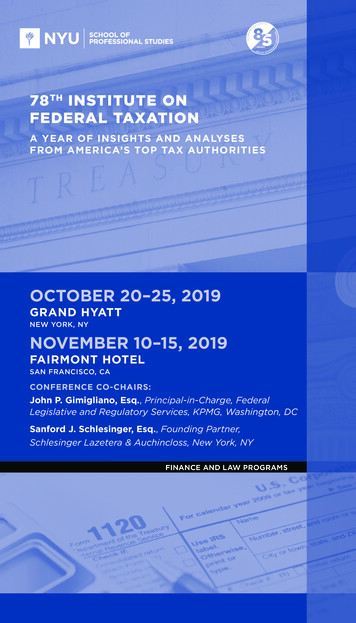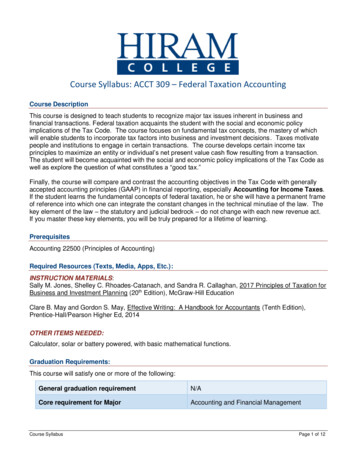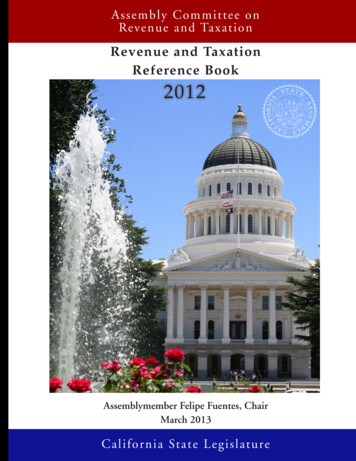
Transcription
A s s e m bly Committee onRe ve nue a nd Ta xa tionRevenue and TaxationReference Book2012Assemblymember Felipe Fuentes, ChairMarch 2013Cali f ornia Sta te Legisla ture
CALIFORNIA STATE LEGISLATUREREVENUE AND TAXATIONREFERENCE BOOK2012Assemblymember Felipe Fuentes, ChairMarch 2013
PREFACEThis Revenue and Taxation Reference Book is designed to answer some of the morecommonly asked questions about California's tax structure. It is written with the generalpublic in mind and gives a broad overview of most of California's major taxes, as well assummaries of some special features of the tax system. Many of the technical features andfine points of the law are excluded in an attempt to keep the material accessible to layreaders.This Reference Book reflects California's tax law as of December, 2012. Generally, taxprovisions that expired or were repealed prior to that date are not described.Many features of the state tax system are described more than once in this ReferenceBook. For instance, certain income tax provisions affecting businesses are described bothas a feature of the Personal Income Tax in Chapter 2B and in Chapter 2C, under theCorporation Tax. Readers should watch for cross-references within the text.The Glossary in Chapter 8 provides short definitions of over 200 terms and acronymscommonly used in tax discussions.Thanks are due to the staff members of the Franchise Tax Board, the Board ofEqualization, and other executive agencies who provided information, advice, andeditorial comment during the preparation of this book. Legislative Counsel also providedassistance on various issues in this book. Their collective assistance ensures that theinformation included is both timely and accurate.The Revenue and Taxation Reference Book has been prepared and maintained over theyears by the staff of the Assembly Committee on Revenue and Taxation.i
TABLE OF CONTENTSPagePREFACEiTABLE OF CONTENTSiiTABLE OF TABLESivCHAPTER 1. CALIFORNIA'S TAX SYSTEMA.B.C.D.Overview of California's Tax RevenuesBasic Facts About Tax LegislationRestrictions on the Taxing Power of the LegislatureWhere to Get Information About State Taxes13917CHAPTER 2. OVERVIEW OF MAJOR TAXES AND REVENUE SOURCESA.B.C.D.E.IntroductionPersonal Income TaxCorporation TaxDetermining the Income of Multistate and Multinational CorporationsSales and Use Tax1921517385CHAPTER 3. OVERVIEW OF OTHER STATE TAXES AND REVENUESOURCESA.B.C.D.E.F.G.H.I.J.K.Alcoholic Beverage Tax and Liquor License FeesCigarette and Tobacco-Related Products TaxInsurance Gross Premiums TaxEstate TaxFuel TaxesMotor Vehicle FeesTimber Yield TaxPrivate Railroad Car TaxEmergency Telephone Users' SurchargeUnemployment Insurance TaxState Disability Insurance Tax99103109113115125131133135137143CHAPTER 4. THE LOCAL PROPERTY TAX147CHAPTER 5. GOVERNMENT APPROPRIATIONS LIMIT: ARTICLE XIIIBOF THE CONSTITUTION173ii
CHAPTER 6. SPECIAL FEATURES OF THE CALIFORNIA TAX SYSTEMA.B.C.D.E.F.G.Overview of Special State Tax Provisions Affecting Senior CitizensSenior Citizens and Disabled Property Tax Postponement ProgramOverview of Special State Tax Provisions for HomeownersHomeowners' ExemptionRenters' CreditOpen Space and Agricultural Land ContractsMobilehome Taxation181185187191195197201CHAPTER 7. OVERVIEW OF CALIFORNIA'S TAX ADMINISTRATION207CHAPTER 8. GLOSSARY OF TAX TERMINOLOGY217iii
TABLE OF TABLESTable 1General Fund Revenues - Fiscal Year 2012-13Table 2California Tax Rates for 201230Table 3Federal Tax Rates for 201231Table 4Changes made by EGTRRA44Table 5Computation of Alternative Minimum Tax for a Hypothetical Corporation69Table 6Use of Unitary Apportionment Formula for a Hypothetical Corporation80Table 7Existing Transactions and Use Taxes (As of 1-1-12)Table 8Property Tax Relief ProgramsTable 9Tax Administration Responsibilitiesiv189-91163215-216
CHAPTER 1AOVERVIEW OF CALIFORNIA’S TAX REVENUESTABLE 1GENERAL FUND REVENUES, FISCAL YEAR 2012-13(In Millions of Dollars)TaxTotal RevenuePercentage ofGeneral Fund BudgetPersonal Income Tax 60,64763.6%Retail Sales and Use Tax(General Fund portion) 20,71421.7%Corporation Tax 7,5807.9%Highway Users Tax -0-.0%Motor Vehicles License Fees 4.04%Insurance Tax 2,0222.1%Estate Tax -0-.0%Liquor Tax 320.3%Cigarette Tax (General Fund portion) 91.09%Other 2,2162.3% 95,394100.0%*TOTAL*May not total 100% due to rounding error.Source: Governor's 2013-14 Budget Summary, General Fund Revenue Sources, FigureSUM-04; Appendix 14, Schedule 8 (Comparative Statement of Revenues)1
2
CHAPTER 1BBASIC FACTS ABOUT TAX LEGISLATIONHIGHLIGHTS Tax Levy Bills Legislative Vote Requirements Constitutional Amendments and Statutory Initiatives Bills with State Mandates on Local Agencies Fiscal Committee Hearings Effective Dates and Operative Dates1.INTRODUCTIONThis chapter summarizes the most important constitutional, statutory, and legislativeprovisions that apply to tax legislation.2."TAX LEVY" BILLSTax Levy Bills Defined. A tax levy is a bill that imposes a state tax, repeals a state tax,or otherwise changes in any material way the rate, base, or burden of a state tax. For thisreason, many bills that deal with taxes are designated as tax levy bills.The Office of Legislative Counsel (Legislative Counsel), which is responsible fordrafting all bills introduced and amended in the Legislature, determines whether a bill is atax levy.Legislative Counsel will classify a bill as a tax levy if its subject matter exclusively orprincipally imposes, repeals, or otherwise modifies the incidence or burden of a state tax.After determining that a bill is a tax levy, Legislative Counsel will include in the title ofthe bill a phrase indicating that the bill is a tax levy. The body of the bill will alsocontain a statement that the measure is a tax levy.Bills that impose, repeal, or modify a state tax and that also contain unrelated provisionsare not designated as tax levies, unless Legislative Counsel determines that the tax levyprovisions are the principal or primary purpose of the bill.3
CHAPTER 1BBASIC FACTS ABOUT TAXLEGISLATIONBills that exclusively or primarily affect the rate, base, or burden of the property tax arealso designated as tax levies. However, a bill that only authorizes a local government topropose a tax to the voters is not a tax levy, because that bill does not directly affect therate, base, or burden of an existing local tax.Bills that deal exclusively or principally with tax administration, including the impositionof penalties and interest, are not tax levies.How Tax Levy Bills Are Treated. The Legislature treats tax levy bills differently fromother bills in the following ways: Tax levy bills take effect immediately [California Constitution, Article IV,Section 8(c)(3).] However, their operative dates may be different (see Section7, below). Tax levy bills are not subject to referendum by the people [CaliforniaConstitution, Article II, Section 9(a).] Tax levy bills are not subject to many of the normal legislative deadlines forthe consideration of bills. Instead, they are treated like urgency bills andConstitutional Amendments. Accordingly, policy and fiscal committees maymeet to hear a tax levy bill at any time other than during those periods whenno committee may meet for any purpose. Similarly, either house may meetfor the purpose of considering and passing a tax levy bill at any time duringthe legislative session.3. LEGISLATIVE VOTE REQUIREMENTS FOR TAX BILLSThe California Constitution establishes legislative vote requirements for all tax bills,including tax levies.Bills requiring a two-thirds vote are those that: Result in any taxpayer paying a higher tax (California Constitution, ArticleXIIIA, Section 3); Contain an urgency clause [California Constitution, Article IV, Section 8(d)]; Classify personal property for differential taxation or that exempt personalproperty from taxation (California Constitution, Article XIII, Section 2); Contain a General Fund appropriation for any purpose other than publiceducation, unless passed as part of the budget [California Constitution, ArticleIV, Section 12(d)];4
CHAPTER 1BBASIC FACTS ABOUT TAXLEGISLATION Override a Governor's veto [California Constitution, Article IV, Section10(a).]; and Amend the provisions of the California Children and Families First Act of1998, an initiative constitutional amendment and statute passed as Proposition10 by the voters in November 1998 (Proposition 10, 1998, Section 8).Bills that amend any portion of the Cigarette and Tobacco Products Tax Law enacted inNovember 1988 by the voters as Proposition 99 require a four-fifths vote.With certain limited exceptions, all other tax bills require a majority vote.4.CONSTITUTIONAL AMENDMENTS AND STATUTORY INITIATIVESSome aspects of state tax law cannot be changed by the Legislature. These instances andthe procedures relating to them are outlined below.Tax Law Set Forth in the Constitution. A constitutional amendment is required tochange any tax law contained in the California Constitution. Proposed constitutionalamendments may be placed on the statewide ballot either by the Legislature or by thepeople through an initiative. Constitutional amendments proposed by the Legislaturemust be adopted by a two-thirds vote of each house and do not require the Governor'ssignature. An initiative, in turn, requires a majority vote of the people.Initiative constitutional amendments must receive valid signatures equal to at least 8% ofthe number of voters who voted in the last gubernatorial election in order to be placed onthe ballot.Statutory Tax Law Enacted by the Voters Through a Statutory Initiative. Ingeneral, an initiative tax statute can only be changed by a vote of the people on anotherstatewide ballot. The proposed change in the law may be placed on the ballot by anotherinitiative or by a bill enacted by the Legislature.Some initiative statutes, however, contain language that allows the Legislature to makechanges without voter approval. These statutes typically identify the types of changesallowed and specify the legislative vote requirement to amend the statute.Initiative statutes must receive valid signatures equal to at least 5% of the number ofvoters who voted in the last gubernatorial election in order to be placed on the ballot.5.BILLS WITH STATE MANDATES ON LOCAL AGENCIESThe California Constitution (California Constitution, Article XIIIB, Section 6) requiresthe state to reimburse local governments for any costs incurred when the state mandates5
CHAPTER 1BBASIC FACTS ABOUT TAXLEGISLATIONlocal government to provide certain new programs or higher levels of service. TheConstitution provides that reimbursement is permissible but not required for mandatesrequested by the local agency affected, legislation defining a new crime or changing anexisting definition of a crime or for mandates enacted before January 1, 1975.Reimbursement is not provided if the mandates are self-financing, have offsettingsavings, require no new duties, or if the new duties result from a ballot measure approvedby the voters. Government Code Sections 17500-17630 provide procedures for theconstitutionally required state reimbursement of mandated local costs.In addition, statutes require reimbursement to local agencies in the following two cases: Enactment of property tax exemptions or new classifications of exemptproperty (Revenue and Taxation Code Section 2229); or, Enactment of sales and use tax exemptions that cause a new loss of revenue(Revenue and Taxation Code Section 2230).Constitutional requirements for reimbursement cannot be waived. Statutory requirementsfor reimbursement may be waived by statute, including the statute creating a newexemption.6.HEARINGS BY LEGISLATIVE COMMITTEESBills materially changing the Revenue and Taxation Code (whether by amendment,addition or deletion) are generally referred to the Assembly Committee on Revenue andTaxation and the Senate Committee on Governance and Finance for policy review.Under current legislative rules, tax bills, like other bills, must be referred to theAppropriations Committee of each house if they do any of the following:oAppropriate money; Result in a substantial expenditure of state money by imposing newresponsibilities on the state, imposing new or additional duties on stateagencies, or liberalizing any state program, function, or responsibility; Result in a substantial gain or loss of revenue to the state; or, Result in a substantial reduction of expenditures by reducing, transferring, oreliminating any existing responsibilities of any state agency, program, orfunction.6
CHAPTER 1BBASIC FACTS ABOUT TAXLEGISLATION7.EFFECTIVE DATES AND OPERATIVE DATESIn order to become law, tax bills, like all bills, must be passed by both houses of theLegislature and signed by the Governor, allowed to become law without the Governor'ssignature, or passed over the Governor's veto [California Constitution, Article IV,Sections 8(b) and 10(a).]The effective date of a bill is the date it becomes law. Tax levy bills, urgency bills, billscalling for an election, and bills making appropriations for the usual current expenses ofCalifornia go into effect immediately upon enactment [California Constitution, ArticleIV, Section 8(c)(3).] Bills that do not take immediate effect (i.e., bills that are not taxlevies or urgency measures or that do not call for an election or make an appropriation)take effect on January 1 following enactment [California Constitution, Article IV, Section8(c)(1).]For most tax bills, the effective date of a bill that takes immediate effect is the day thestatute is chaptered by the Secretary of State. However, unless specified otherwise,personal income tax and corporation tax bills apply to taxable years beginning on or afterthe January 1 preceding enactment (Revenue and Taxation Code Sections 17034, 18415,and 23058). For example, a bill enacting an income tax credit that is chaptered by theSecretary of State during 2010 will apply to
This Revenue and Taxation Reference Book is designed to answer some of the more commonly asked questions about California's tax structure. It is written with the general public in mind and gives a broad overview of most of California's major taxes, as well as summaries of some special features of the tax system. Many of the technical features and fine points of the law are excluded in an .
